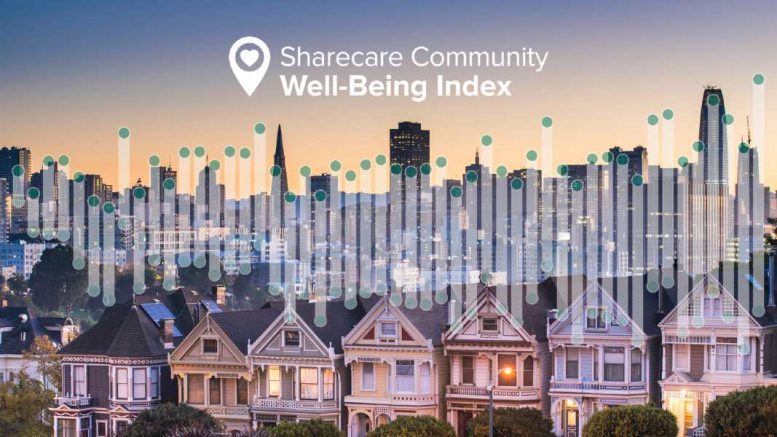Sharecare’s Community Well-Being Index is based on scores and rankings across 383 metro areas and 3,142 counties in the US. San Francisco ranked healthiest metro area in US; highest- and lowest-ranked counties in Virginia showcase sharpest contrast of any state
During a year that tested Americans’ resolve in multiple ways, metropolitan areas in the U.S. exhibited broad resilience and well-being improvement throughout 2020 while gaps persisted – and, in many cases, increased – in rural communities, according to a report published today by digital health company Sharecare in partnership with the Boston University School of Public Health (BUSPH).
For the second year in a row, the San Francisco-Oakland-Hayward, California, MSA topped Sharecare’s Community Well-Being Index rankings, while Pine Bluff, Arkansas, lagged the rest of the nation. The new findings, covering all 383 Census Bureau-defined MSAs and all U.S. counties, reveal how the decisions communities make about their built environment and the cultures of well-being they develop can bend the trajectory of their collective health outcomes. Sharecare’s Index measures the overall health of communities on the basis of 10 domains representing individual well-being factors – physical, community, social relationships, financial, and sense of purpose – and social determinants of health – healthcare access, food access, resource access, housing and transportation, and economic security.
“Building on our earlier release of state rankings, Sharecare and BUSPH’s investigation into U.S. community well-being trends in 2020 has demonstrated the array of factors that shape well-being at both a community and individual level,” said Dr. Kimberly Dukes, executive director of BUSPH’s Biostatistics & Epidemiology Data Analytics Center. “Through the Index’s breadth, depth, and sophisticated statistical techniques, we will continue to explore both macro and micro trends that chart the trajectory of community well-being across time and place.”
San Francisco leads nation in community well-being
The Greater San Francisco area’s community well-being was bolstered by strong performance across the Index’s domains, in particular housing and transportation (#1); food access (#4); financial well-being (#3); physical well-being (#4); social well-being (#4); and purpose well-being (#5).
Meanwhile, Pine Bluff ranked in the bottom quintile for eight out of 10 domains, including the lowest levels of community and social well-being in the country. Though the Index revealed that Pine Bluff’s overall well-being is the worst in the U.S., the city secured a top 10 position for the resource access domain, indicating a strong presence of key resources such as libraries, churches, senior employment, and more.
MSAs in 2020 broadly mirrored trends outlined in Sharecare’s May report ranking states’ well-being. While social determinants of health did not differ much, most individual well-being factors – physical, community, social, and purpose – trended positively from 2019 to 2020. The only exception was financial well-being, which declined amid COVID-19 economic headwinds.
Consistent with trends from the 2020 state rankings, counties in metropolitan areas scored nearly seven points higher on the Index’s 100-point scale than counties in non-metropolitan areas. Metro counties scored higher for all domains except resource access, a measure of the proximity of community resources such as libraries, churches, and more.
The following MSAs round out the top five positions on Sharecare’s Community Well-Being Index:
- San Francisco-Oakland- Hayward, CA
- San Jose-Sunnyvale- Santa Clara, CA
- Washington-Arlington-Alexandria, DC-VA-MD-WV
- Boston-Cambridge- Newton, MA-NH
- Bridgeport-Stamford-Norwalk, CT
Conversely, the five MSAs ranked lowest on the Index are:
- McAllen-Edinburg-Mission, TX
- Las Cruces, NM
- Sumter, SC
- Farmington, NM
- Pine Bluff, AR
Counties in Virginia showcase sharpest contrast in well-being of any state
The challenges of 2020, from the COVID-19 pandemic to civic unrest, exacerbated existing disparities in opportunity and outcomes that often divide communities. To further explore critical differences in community health across geographies, Sharecare and BUSPH identified the states with the greatest gaps between their highest- and lowest-ranked counties.
Virgnia represented the greatest divide in community well-being, with over 70 points on the Index’s scale separating the state’s top- and bottom-ranked counties. Other states with stark differences in community well-being across county lines included South Dakota, Colorado, Alaska, and North Carolina.
“It is critical that state and local governments, healthcare policymakers, and community leaders understand the impact that inequities in access to resources, food, and economic security have on people’s physical and mental well-being,” said Elizabeth Colyer, senior vice president and head of the Community Well-Being Index at Sharecare. “The differences we observed across counties in Virginia represent just one example of ‘haves’ and ‘have nots’ in our country, and it is our hope that these insights encourage data-driven dialogue and the adoption of solutions that transform health equity, opportunity, and outcomes for all.”
To arrive at the 2020 results, Sharecare and BUSPH conducted online surveys with 453,705 U.S. residents aged 18 and older and analyzed more than 600 elements of social determinants of health from additional data sources. Results are nationally representative. To read the full report and project methodology, visit wellbeingindex.sharecare.com/reports/.

